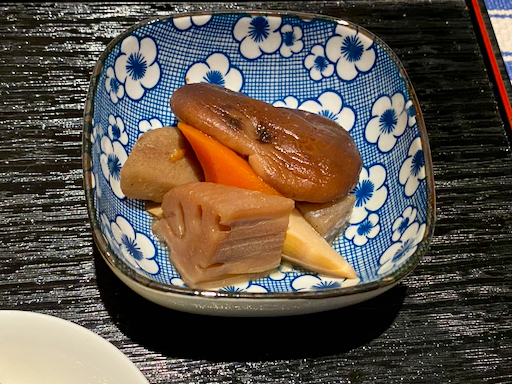This is a note mostly to ourselves to chronicle the steps we use to consistently make thick, creamy and flavorful homemade yogurt. My wife has been making yogurt from the starter she got from "culture for health" for some time. Initially, following the instructions that came with the starter, the first few batches were OK but they resulted in a thin watery yogurt that we could basically drink. The yogurt was made at room temperature which worked in the summer but not in the winter. The batch she made when it turned cold was a "failure". She ended up throwing it out. When a second cold weather batch also failed, somehow dawned on her that the yogurt wasn't forming because it wasn't warm enough. Instead of throwing it out she put it in the oven with the heat off but the light on and VIOLA Le Yogurt! She then went through a "trial-and-error" process for some time and finally nailed a fail-proof process that she has been using to make a wonderful thick, creamy, slightly sweet, slightly tangy yogurt that we really like.

During this process we realized that we needed some equipment which would allow precise temperature and timing controls. My wife did all the work of trial-and-error while I provided scientific advice and explanation.
Equipment:
1. Slow cooker (one gallon capacity) (#1 picture below)
2.
Proofing box with temperature control (We use
Brod-and Taylor's, #8 picture below)
3. Temperature probe with high and low temperature alarm (we use
Thermoworks ChefAlarm® Cooking Alarm Thermometer and Timer). (#2 picture below)
Ingredients:
1 gallon whole pasteurized milk
1/4 cup heirloom yogurt
Method:
1. Heat 1 gallon of whole milk in a slow cooker on "high" (with the temperature probe inserted) to 180F (This takes a few hours. Starting at 6:30AM it will reach temp about 10:30 or 10:45AM).
2. Using the cooking alarm thermometer, the high temperature alarm will sound when the milk reaches 180F.
3. Turn the slow cooker to "low" and maintain the temperature for 30 minutes (temperature will keep climbing to near 185F).
4. Turn off the slow cooker.
5. Because a skin forms on the surface of the milk (#3), skim it off and strain the milk through a fine sieve or a sieve lined the with cheese cloth (#4) into a metal dutch oven (This catches any other pieces of milk skin that may have formed). Cover the dutch oven with plastic wrap and insert the temperature probe (#6).
6. Let the milk cool to 98 -100F (This cooling can take hours and would mean the yogurt could not be finished in one day. It would have to stay overnight. My wife cannot wait that long so she puts the dutch oven in an ice water Bain Marie to hasten the cooling ( #5) If it goes into the Bain Marie at 10 :45 it will have reached the low temp about 12:00 noon. The low temperature cooking alarm thermometer will sound when the temperature cools to 100F, #6).
8. Meanwhile, preheat the proofing box to 99F (#9) while the milk is cooling.
9.When the milk cools to 100F and feels about body temperature when tested with a finger, inoculate the milk with 1/4 cup of the previous batch of home-made yogurt.
10. Divide the mixture into 4 mason jars (#7), close the lids, and place them in the 4 corners of the proofing box (the center position is hottest part and not good for the yogurt. No need for a water tray) (#10).
8. Incubate for about 9 hours. (If the jars go in the proofing box at Noon they can be removed at around 9:00 PM.
9. Take them out and let them cool to room temperature.
10. Refrigerate at least overnight before tasting.

Semi scientific explanation of how these steps work:
1. Reason for heating the milk: The main milk protein casein coagulates or makes a protein meshwork in the presence of lactic acid as the process of making yogurt. The heating process (steps #1 and 2 above) denatures another protein; a major whey protein called "lactoglobulin". Since thick yogurt needs the participation of the most protein available to make a thicker protein meshwork and, hence, a thicker yogurt, denaturing the lactoglobulin increases the protein available for this process. If not heated, the lactoglobulin remains dissolved and does not participate in making the protein meshwork.
2. Initially my wife covered the mason jars with cheese cloth fastened by a rubber band. We later learned that an air-tight lid (step #7 above) works even better. The bacteria in yogurt (lactobacilli and others) ferment anaerobically (i.e. without oxygen) to break down lactose and other milk sugars to lactic acid. So there is no need for oxygen to be present.
3. Incubation time and temperature (steps #7 and #8): Since biochemical or enzymatic reactions accelerate with increased temperature within the range (
Michaelis-Menten kinetics), the higher the incubation temperature the faster the fermentation. Some recipes use higher temperature and shorter incubation time. The temperature and time may influence the consistency and flavors (such as tartness) of the resulting yogurt. We thought slower and longer (99F for at least 9 hours) produced the best yogurt.
4. Although low-temperature (step #10) will slow the fermentation, the yogurt appears to continue developing and produces firmer but creamer texture with overnight refrigeration. We also found that over time the yogurt continues to thicken and become creamier.
We really like this homemade yogurt. It is very creamy and smooth in texture. The flavor while mild is still distinctive. It is slightly sweet with a mild tang. We eat this yogurt almost every morning with a little fresh fruit such as blueberries or strawberries and a little bit of sugar. We will probably won't go back to a commercial brand.















